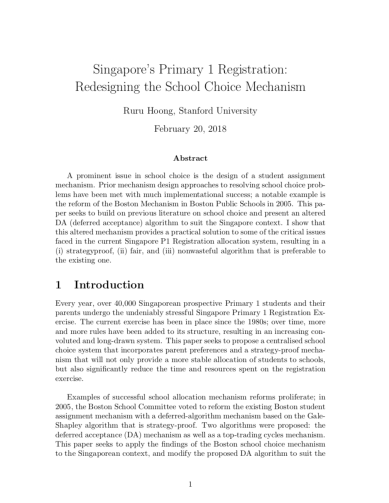Education has always been a topic close to my heart; when I was presented with a chance to write a paper during a Market Design class, taught by a professor who is now my major advisor (Professor Paul Milgrom), it was only natural that I would write about reforming Singapore’s P1 school choice mechanism. It took awhile, but it’s now been published in the Berkeley Economic Review’s Spring 2018 edition! Like the Stanford Economics Journal (of which I am a co-Editor-in-Chief for this year), the Berkeley Economic Review is an undergraduate peer-reviewed academic economics journal.
Every year, over 40,000 Singaporean prospective Primary 1 students and their parents undergo the undeniably stressful Singapore Primary 1 Registration Exercise. The current exercise has been in place since the 1980s; over time, more and more rules have been added to its structure, resulting in an increasing convoluted and long-drawn system. The exercise is stressful for all parents; and even more disproportionately so for those with less educational background/ lower financial resources, because it involves strategising (and oftentimes, taking time off work in order to sign their children up for certain phases).
In my paper (the original can be found here), I propose a centralised school choice system that incorporates parent preferences and a strategy-proof mechanism that will not only provide a more stable allocation of students to schools, but also significantly reduce the time and resources spent on the registration exercise. Systems like these have been successfully implemented in many places: the city of Boston faced many of the same problems the Singapore P1 system faces today, so a number of economists (including Stanford professor and Nobel Laureate Al Roth) designed and (with the support of the Boston School Committee) implemented the original Boston school choice mechanism to much success.
This mechanism, adapted to Singapore’s current P1 registration system, can be quite straightforwardly implemented in the Singapore context. I hope we can use the successful reform of the Boston mechanism as an impetus to prompt the reexamination of the Singapore mechanism. Perhaps we can even tackle questions that lie further than what is presented in my paper: we should reconsider normative questions like whether or not it would be a good idea to remove distance-priority or phase quotas; research has shown that that quotas can actually be detrimental to the minority it tries to protect, because they potentially make competition for other schools higher. These important questions warrant future investigation within the Singapore context, and are worth consideration should the Ministry decide to redesign the Primary 1 Registration Exercise.
Feel free to share and comment – I welcome any suggestions or critique!



congrats!!!!!!! proud of you!!!!!!
Kind regards
Wei Han
On Sat, Sep 8, 2018 at 7:14 AM, ruru’s ruminations. wrote:
> ruruhoong posted: “Education has always been a topic close to my heart; > when I was presented with a chance to write a paper during a Market Design > class taught by a professor who is now my major advisor (Professor Paul > Milgrom) it was only natural that I would write about r” >
did not get past page 8 coz page 8 onwards I dun understand, you must explain to me someday
Kind regards
Wei Han
On Sat, Sep 8, 2018 at 7:14 AM, ruru’s ruminations. wrote:
> ruruhoong posted: “Education has always been a topic close to my heart; > when I was presented with a chance to write a paper during a Market Design > class taught by a professor who is now my major advisor (Professor Paul > Milgrom) it was only natural that I would write about r” >
Hahaha alright mummy <3